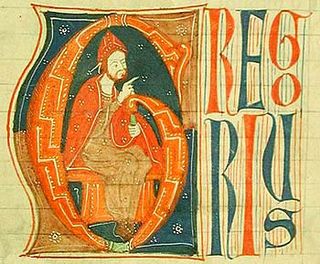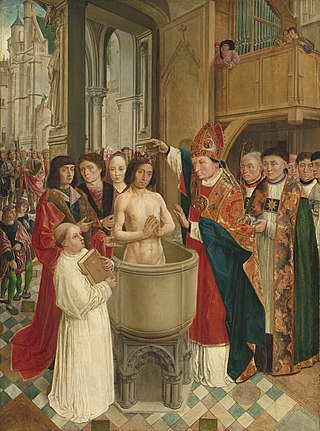Related Research Articles

Pope Gregory IX was head of the Catholic Church and ruler of the Papal States from 19 March 1227 until his death in 1241. He is known for issuing the Decretales and instituting the Papal Inquisition, in response to the failures of the episcopal inquisitions established during the time of Pope Lucius III, by means of the papal bull Ad abolendam, issued in 1184.

Pope Gregory XIII, born Ugo Boncompagni, was head of the Catholic Church and ruler of the Papal States from 13 May 1572 to his death in April 1585. He is best known for commissioning and being the namesake for the Gregorian calendar, which remains the internationally accepted civil calendar to this day.

Pope Gregory I, commonly known as Saint Gregory the Great, was the bishop of Rome from 3 September 590 to his death. He is known for instituting the first recorded large-scale mission from Rome, the Gregorian mission, to convert the then largely pagan Anglo-Saxons to Christianity. Gregory is also well known for his writings, which were more prolific than those of any of his predecessors as pope. The epithet Saint Gregory the Dialogist has been attached to him in Eastern Christianity because of his Dialogues. English translations of Eastern texts sometimes list him as Gregory "Dialogos", or the Anglo-Latinate equivalent "Dialogus".

Gregory of Tours was a Gallo-Roman historian and Bishop of Tours during the Merovingian period and is known as the "father of French history." He was a prelate in the Merovingian kingdom, encompassing Gaul's historic region.
Pope Fabian was the bishop of Rome from 10 January 236 until his death on 20 January 250, succeeding Anterus. A dove is said to have descended on his head to mark him as the Holy Spirit's unexpected choice to become the next pope. He was succeeded by Cornelius.

Clotilde, also known as Clothilde, Clotilda, Clotild, Rotilde etc., was a Queen of the Franks. She was supposedly descended from the Gothic king Athanaric and became the second wife of the Frankish king Clovis I in 493. The Merovingian dynasty to which her husband belonged ruled Frankish kingdoms for over 200 years (450–758).

Martial, called "the Apostle of the Gauls" or "the Apostle of Aquitaine", was the first bishop of Limoges. His feast day is 30 June.

Venantius Honorius Clementianus Fortunatus, known as Saint Venantius Fortunatus, was a Latin poet and hymnographer in the Merovingian Court, and a bishop of the Early Church who has been venerated since the Middle Ages.

Gatianus in the third century AD was the founding bishop of the see of Tours. He was one of the "seven apostles of Gaul" commissioned by Pope Fabian to evangelize in the region.

Stremonius or Saint Austremonius or Saint Stramonius or Austromoine, the "apostle of Auvergne," was the first Bishop of Clermont. He is venerated as a saint in the Catholic Church.

Saint Hermenegild or Ermengild, was the son of king Liuvigild of the Visigothic Kingdom in the Iberian Peninsula and southern France. He fell out with his father in 579, then revolted the following year. During his rebellion, he converted from Arianism to Catholicism. Hermenegild was defeated in 584 and exiled. His death was later celebrated as a martyrdom due to the influence of Pope Gregory I's Dialogues, in which he portrayed Hermenegild as a "Catholic martyr rebelling against the tyranny of an Arian father."

Remigius was the Bishop of Reims and "Apostle of the Franks". On 25 December 496, he baptised Clovis I, King of the Franks. The baptism, leading to about 3000 additional converts, was an important event in the Christianization of the Franks. Because of Clovis's efforts, a large number of churches were established in the formerly pagan lands of the Frankish empire, establishing a distinct Catholic variety of Christianity for the first time in Germanic lands, most of whom had been converted to Arian Christianity.

Maurus (512–584) was the first disciple of Benedict of Nursia. He is mentioned in Gregory the Great's biography of the latter as the first oblate, offered to the monastery by his noble Roman parents as a young boy to be brought up in the monastic life.

Gregory of Utrecht was born of a noble family at Trier. He became a follower of Saint Boniface, who sent him to study at the Monastery of Saint Michael at Ohrdruf. He then accompanied Boniface on his missionary journeys. In 750, Boniface appointed Gregory abbot of St. Martin's Monastery in Utrecht. St. Martin's became a centre of learning and missionary activity. When, in 754, Eoban left to accompany Boniface on their last missionary trip, Gregory was tasked with administering the diocese of Utrecht, which he did faithfully for the next twenty-three years until his death in 776.

Exuperius was Bishop of Toulouse at the beginning of the 5th century.
Saint Hospitius was a French recluse who, according to tradition, had been a monk in his native Egypt towards the beginning of the 6th century. He immigrated to Gaul and retired to a dilapidated tower, situated on the peninsula of Cap Ferrat, a few miles east of Nice.

Saint Aredius, also Yrieix, Abbé d'Attanum and Arède d'Atane, was chancellor to Theudebert I, king of Austrasia, and later Abbot of Attane. He founded the monastery of Attane, which was renamed after his death Saint-Yrieix in his honour. The town at the site became known as Saint-Yrieix-la-Perche. Several other French communes are also called Saint-Yrieix after him.

Saint Bertha or Saint Aldeberge was the queen of Kent whose influence led to the Christianization of Anglo-Saxon England. She was canonized as a saint for her role in its establishment during that period of English history.

The Church Fathers, Early Church Fathers, Christian Fathers, or Fathers of the Church were ancient and influential Christian theologians and writers who established the intellectual and doctrinal foundations of Christianity. The historical period in which they worked became known as the Patristic Era and spans approximately from the late 1st to mid-8th centuries, flourishing in particular during the 4th and 5th centuries, when Christianity was in the process of establishing itself as the state church of the Roman Empire.

Christianization of the Franks was the process of converting the pagan Franks to Catholicism during the late 5th century and early 6th century. It was started by Clovis I, regulus of Tournai, with the insistence of his wife, Clotilde and Saint Remigius, the bishop of Reims.
References
- ↑ Gregory of Tours. A History of the Franks. Pantianos Classics. 1916
- ↑ https://www.catholic.com/encyclopedia/hospitius-saint, The Catholic Encyclopedia, Hospitius, Saint, 1912, retrieved July 19th 2023